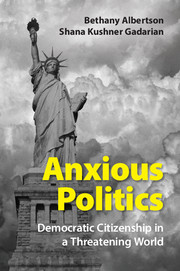Book contents
- Frontmatter
- Dedication
- Contents
- List of Tables
- List of Figures
- Acknowledgments
- Prologue
- 1 Anxiety in Democratic Life
- 2 What's Your Worry?: Finding and Creating Anxiety in the American Public
- 3 Anxiety, Immigration, and the Search for Information
- 4 Don't Worry, Be Trusting?: The Effect of Anxiety on Political Trust
- 5 The Politics of Anxiety: Anxiety's Role in Public Opinion
- 6 Anxiety and Democratic Citizenship
- Appendix
- References
- Index
2 - What's Your Worry?: Finding and Creating Anxiety in the American Public
Published online by Cambridge University Press: 05 September 2015
- Frontmatter
- Dedication
- Contents
- List of Tables
- List of Figures
- Acknowledgments
- Prologue
- 1 Anxiety in Democratic Life
- 2 What's Your Worry?: Finding and Creating Anxiety in the American Public
- 3 Anxiety, Immigration, and the Search for Information
- 4 Don't Worry, Be Trusting?: The Effect of Anxiety on Political Trust
- 5 The Politics of Anxiety: Anxiety's Role in Public Opinion
- 6 Anxiety and Democratic Citizenship
- Appendix
- References
- Index
Summary
It did what all ads are supposed to do: create an anxiety relievable by purchase.
David Foster Wallace, Infinite Jest (1996)A survey of American politics offers an embarrassment of riches when looking for anxiety. Anxiety appears to be everywhere, especially during campaign seasons. Terrorist attacks, crime waves, not to mention economic downturns, are just a few of the many areas of politics that are infused with anxiety. We chose four areas to focus on in our research: immigration, public health, terrorism, and climate change. Our case selection was driven first by a very practical concern: the policy areas had to trigger anxiety at least among a subset of the population. Then, we sought variation on two important dimensions for our theory: (1) whether the issue is inherently threatening or threatening dependent on framing and (2) the partisan dimensions of the issue (e.g., whether anxiety is concentrated on the left, the right, or spread among the population evenly, and whether a party is more closely associated with the issue). Public health crises and terrorist threats trigger widespread anxiety (although as these issues move further away from the crisis moment, they often become politicized). On the other hand, climate change tends to trigger more anxiety on the left, and immigration worries are more prevalent on the right. This variation is used to demonstrate the potential for and limits on anxiety as a persuasive tool. In subsequent chapters, we use experiments to study the relationship between anxiety and three coping mechanisms (learning, trust, and attitudes) across these different issue areas.
Our goal in this chapter is to offer an overview of our substantive cases. We begin by explaining our choice of policy areas and the important dimensions on which they differ. We also establish that each case has been the subject of considerable anxiety for the mass public through survey data. Finally, we describe our approach to studying the effects of anxiety on the mass public. We use three different experimental techniques to generate anxiety: (1) thought listings, (2) news stories, and (3) campaign ads. Together, these offer a full picture of how anxiety can affect the ways that citizens engage with politics.
ANXIETY-INDUCING THREATS
Societal upheavals, epidemics, wars, and campaigns possess the ability to force the public to stop, pay attention, and react emotionally. Some events are obvious and widely recognized as threats. Events that evoke dread and fear of death, that seem uncontrollable, that have catastrophic consequences for individuals and society (Lichtenstein et al. 1978) can create anxious feelings for everyone.
- Type
- Chapter
- Information
- Anxious PoliticsDemocratic Citizenship in a Threatening World, pp. 19 - 42Publisher: Cambridge University PressPrint publication year: 2015



